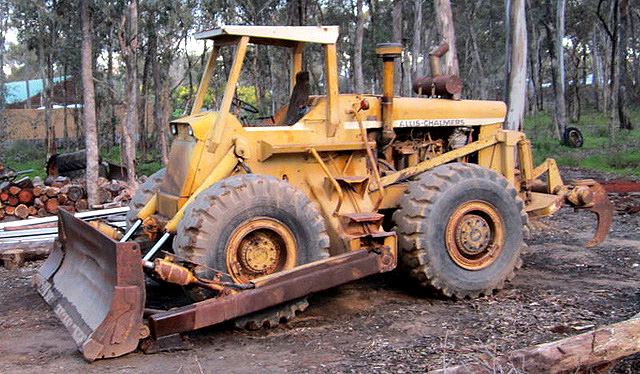An exceptionally versatile tool, the wheel loader has found a use in all phases of construction as well as quarry and aggregate production, material recycling, reclamation, rubbish transfer and heavy mining. BY RICHARD CAMPBELL
Early machines were based largely on agricultural two-wheel drive tractors and operated back-to-front with the lifting arms, or mast, mounted on the tractor’s rear with the machine actually operating in reverse!
The first really commercially-successful purpose-built machines were designed by the Frank G Hough Company, which ultimately became a very important arm of the International Harvester Corp, Payline division.
These machines really started making an impact during the late 1940s.
Before too long almost every equipment manufacturer had its own variant of a wheel loader for sale.
By the end of the decade, Euclid and Caterpillar joined the market.
Among this plethora of wheel loaders was Tractomotive, a wholly owned division of Allis-Chalmers.
Allis-Chalmers had had an association with Tractomotive for a considerable period of time before A-C acquired them outright in 1959.
Tractomotive built the pipelaying side booms, rippers and loader attachments for Allis’ track type tractors and also utilised Allis-Chalmers wheel tractors as a base for its own wheel loaders. It was a very convenient marriage.
As was the case with most of their competitors, Tractomotive used rigid frame two-wheel drive tractors as the base unit for its wheel loaders.
Tractomotive called its wheel loaders “Tracto-Loaders” and they were sold and serviced through the Allis-Chalmers dealer network.
Its model TL-10, a one cubic yard loader, sold particularly well and was in continuous production from 1951 through 1964.
It was a ground-breaking machine for Tractomotive as it was designed and built as a wheel loader, not an adaptation of an existing tractor.
Available with either a gasoline or diesel engine, the loader was the first Tractomotive machine to feature a torque converter drive.
Their next offering, the model TL-12, was a runaway success worldwide and sold in the thousands.
As the first Tractomotive machine to feature all wheel drive and a torque converter drive power shuttle transmission, the TL-12 competed head on with Case and Hough for the lion’s share of the wheel loader market.
Weighing in at around six tons, and carrying a 1.25 cubic yard bucket, the TL-12 was produced from 1954 until 1965 when it was replaced by the articulated steer model 545.
It was available with either a 63 horsepower, 4-cylinder gasoline engine, or a 77 horsepower, 6-cylinder diesel, both manufactured by Allis-Chalmers.
Following on the success of the TL-12 came the TL-14 (3 cubic yards), TL-16 (4 cubic yards), TL-20 (5 cubic yards), TL-30 (6 cubic yards) and the giant TL-40 that was rated at a massive (for the time) 7 cubic yards bucket capacity.
The TL-40 also spawned Allis-Chalmers’ attempt at a wheel dozer named the D-40 that was produced in limited quantities.
These were the last rigid frame, rear wheel steer loaders made by Tractomotive before Allis-Chalmers completely absorbed the company and introduced its own indigenously designed articulated steer machines, the 345, 545, 645, 745 and 945.
However, the Tractomotive name continued in the new A-C series of wheel loaders that were referred to as TL545, TL645 etc., a direct recognition of the new machines’ distinguished heritage.
Tractomotive Wheel Loaders Basic Layout
All of the Tractomotive-designed wheel loaders featured a rigid (non-articulating) main frame with rear wheel, power boosted steering.
The operator sat well up front with a good view of the bucket and work area with the engine behind him forming part of the machine’s counterweight.
Early machines featured a foot clutch but Tractomotive’s engineers were pioneers in fitting power shuttle transmissions to these machines reducing the amount of shifting required to perform a work cycle.
As time progressed the shuttle transmissions were replaced by full powershift types, usually supplied by Allison or Twin-Disc.
Tractomotive always offered the prospective buyer a choice of powerplants, either gasoline or diesel of various outputs.
As gasoline became progressively more expensive this option was dropped in favour of diesel only.
Work tools were available in a wide range of types from general purpose and rock buckets through to dozer blades, snow blowers, side booms and forks, the wheel loader being the original all terrain forklift.
Drott also made its 4-in-1 bucket available to Tractomotive where a little more versatility was required. This necessitated the fitting of an extra valve to the hydraulic system.
One of the drawbacks of a rigid frame loader is the area required to manoeuver, however the chief concern was one of safety.
Loader lift arms, tucked close into the side of the machine’s chassis, were capable of amputating a careless operator’s arms when they lowered making the machines quite dangerous to drive.
The narrow chassis also meant that the operator’s compartment was cramped and a long shift in a machine of this type could be quite tiring.
Cabs, when fitted, were noisy and poorly insulated and very difficult to get out of quickly should the machine overturn.
None-the-less, Tractomotive’s contribution to the evolution of the wheel loader was an important one and should not go unrecognised.
The New Zealand Connection.
Tractomotive wheel loaders were sold widely throughout New Zealand by CablePrice in the North Island and Andrews & Bevan in the South Island.
Their rugged simplicity and reliability was well liked and many of them survived into the 1990s as backup machines for newer wheel loaders whose increasing complexity made quick repairs an unlikely event.
Unfortunately records of deliveries of the various models no longer exist and one can only speculate on how many were put into service here.
For the Model Collector
At the time of writing, no models exist of any of Tractomotive’s wheel loaders.
Considering their contribution to the earthmoving industry this is a great pity and it is to be hoped that some manufacturer will remedy this shortcoming before too long.

